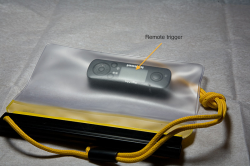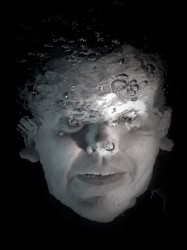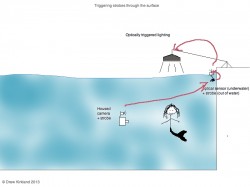A recent forum post asked about triggering strobes outside the water from a housed camera underwater.
(For the sake of simplicity, I’m assuming that we’re talking about a swimming pool shoot here.)
I know this is a bit obscure, but I’m not the only one to have tried it …
Safety warning
I’m going to start with a couple of caveats.
Firstly, high-powered electronics and water don’t mix well with models, safety crews and photographers. So keep all studio strobes well away from the pool. I’m not a health and safety expert, so do check out your rig with a professional if you want to try pushing any envelopes.
[Edit 12/1/2014 : Following advice from Jean Bruneau of Aquatica, even a speedlight can deliver a “probably non-lethal” jolt when the capacitor discharges in water. It’ll also cease to function. I’ll be dealing with my workaround in a future post. And do remember that with repeated use, that is a “when” rather than an “if”.]
Secondly, before you start taking photos underwater, make sure you understand how human physiology works underwater. A SCUBA course will give you a good introduction. Then come up with a briefing for your models, so they understand as well.
Thirdly, make sure you’ve someone in the water whose primary concern is that the model is safe and comfortable. Your job is to get the photos, and it’s easy to get fixated on that task.
If it’s a commercial shoot (i.e. someone’s getting paid) in the UK , then you’ll need to follow lots of HSE rules. There may well be similar regulations in your part of the world.
Don’t take short cuts on safety. Obey the laws. Especially the Laws of Physics.
Triggering technologies
We’ve all got used to using radio triggers in our topside shooting. Unfortunately, these don’t have a big range underwater. We’re talking inches here, so that means they’re pretty much unusable.
So if we’re using surface speedlights, we’re limited to optical triggering – where the flash of one strobe triggers another. It’s less robust than radio triggers on the surface, and you can forget your fancy TTL systems, but it’s the best you’re gonna get.
Dedicated underwater strobes (I use INONs) are usually triggered through either a fibre-optic cable that picks up the camera’s on-board flash, or through a cable connection connecting to the camera’s hotshoe, via a bulkhead in the housing.
Some strobes claim “wireless” triggering. Mostly, this means “there aren’t any wires”, and if it does work, it’s by using mirrors.
How you trigger the flash attached to (or enclosed in) your camera housing isn’t entirely relevant.
But this is relevant to the rest of the story.
Snell’s Window
So can’t we use the underwater flash to optically trigger a surface strobe ? Or a surface flash to trigger our underwater lights ?
Well, maybe it’ll work; it depends on whether enough light passes through the surface, but we’re limited by a bit of physics called Snell’s Window, so it’s probably best to make sure.
We can use Snell’s Window creatively as well (I’ll leave you to figure that out), but getting light through in a dynamic shoot can be a bit hit-and-miss.
Triggering Topside flash from Underwater
So … time for a dodgy graphic …
OK. The housed underwater camera is connected to a flash, which (depending on preference) may light the subject.
But most importantly, it triggers an optical sensor attached to a second light – a speedlight. Most of these have an optical sensor of their own built in, but an external sensor can help you get them a bit further apart.
Because the sensor needs to be under the water (to “see” the on-board flash), while the head of the flash needs to be above the surface, to trigger the flash that actually provides the light.
Then, wrap all of this up in a nice watertight bag, such as an ewa-marine pouch. I position the gadgets inside with gaffer tape, so they don’t shift around. It’s obviously a good idea if the buttons are turned so you can see which you’re pressing.
Squeeze out as much air as possible (and you may need to add a bit of lead), and fix them to the side (if possible). Or you’ll need to find a way to weight them to the bottom.
Above water, you’ll have another lighting rig, maybe with a softbox attached. Remember to counterweight the boom, so it doesn’t topple in and fry your flashes.
Triggering Underwater flash from a Topside camera
This is just pretty much the other way around, except that you can use a radio trigger (YAY) in the housing.
So in this case, the trigger needs to be above the surface, while the strobe head – this time – is under the water (and- hopefully – pointed in the general direction of any underwater lights you’ve got set up).
Your underwater strobes can be preset, and, of course, shouldn’t have their optical cables connected. And, sorry, I should have mentioned – you’ll need a strobe that can be triggered optically. Some need cable connections. Someone else can sort out how to make that one work …
The strobe levels will need to be controlled manually (or on “auto”). No TTL here …
My Selfie
Just as a quick coda, I used this latter technique to grab a selfie.
I set up a time delay on the camera, and attached a remote trigger, so I could set it off while I was in the pool. I used a Giottos tripod, with a centre column that can be switched forward. And I put a couple of kg of lead on the other end.
I used a standard kit lens because, lets face it, IQ isn’t going to be a big factor.
Here are some more things about the setup I used :





